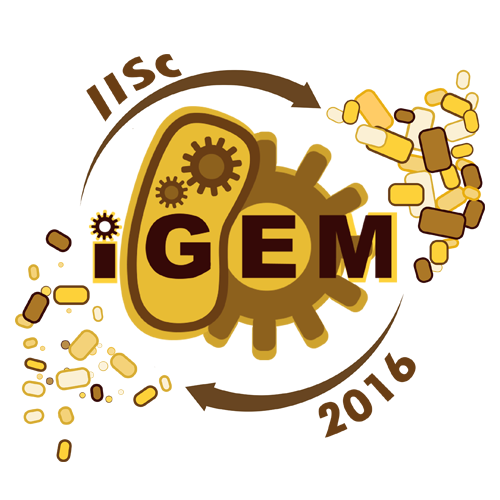Quorum sensing
Null model
A model was constructed to find out the optimal conditions for the production of the protein of interest, which is controlled by quorum sensing. It was assumed that the synthesis of autoinducer molecules is negligible before the log phase in the bacterial growth curve kicks in, and also that after protein protein production begins, the cells practically stop dividing. An expression was found for the optimal ratio of the threshold autoinducer concentration to the rate of autoinducer synthesis to maximize the synthesis of the recombinant protein.
Assumptions
- The protein production starts in the log phase of bacterial growth.
- The switch that stops the bacterial growth takes a small time $t_s$.
- The amount of quorum sensing molecule (A) at time $t=0$ is $0$.
- $A$ -- Amount of quorum sensing molecule
- $A_t$ -- Threshold amount of quorum sensing molecule (Adjustable parameter, by changing affinity of quorum sensing molecule for the switch)
- $n_i$ -- Initial number of bacteria in solution
- $n_f$ -- Final number of bacteria in solution (at threshold)
- $r$ -- Rate of production of quorum sensing molecule per bacteria (Adjustable by changing promoter)
- $g$ -- Inverse of generation time
Since the bacterial is in the log phase, the number of bacteria at time $t=t$, if the initial number of bacteria was $n_i$ is,
\begin{align*}
n = n_i2^{gt}
\end{align*}
So, the rate of production of the quorum sensing molecule, if the rate of production by each bacteria is $r$ is,
\begin{align*}
\frac{dA}{dt} = rn_i2^{gt}
\end{align*}
Now, if we solve it,
\begin{align*}
dA = rn_i2^{gt}dt
\end{align*}
Integrating,
\begin{gather*}
A = \frac{rn_i2^{gt}}{g}\\
\Rightarrow A_t = \frac{rn_i2^{gt}}{g} = \frac{rn_f}{g}\\
\Rightarrow n_f = \frac{A_tg}{r}
\end{gather*}
Now, expressing $n_f$ in terms of $n_i$, and taking the time to reach threshold is $t^*$,
\begin{gather*}
n_i2^{gt^*} = \frac{A_tg}{r}\\
\Rightarrow t^* = \frac{1}{g}\log_{2}\frac{A_tg}{rn_i}
\end{gather*}
If we modify our equation slightly to incorporate the fact that production at $t=0$ is $0$, we get,
\begin{gather*}
A(t, n_i) = \frac{rn_i}{g} \left( 2^{gt}-1 \right)\\
\Rightarrow t^* = \frac{1}{g}\log_{2}\left(\frac{A_tg}{rn_i}+1\right)
\end{gather*}
Considering the fact that the switch takes time $t_s$ to work,
\begin{align*}
A(t^*+t_s, n_i) &= \frac{rn_i}{g} \left( 2^{g(t^*+t_s)}-1 \right)\\
&= \frac{rn_f2^{gt_s}}{g} - \frac{rn_i}{g} \text{ (because $n_f=n_i2^{gt^*}$)}
\end{align*}
The cell density after the switch turns on is $n_f'$. So,
\begin{align*}
n_f' &= n_i2g^{(t^*+t_s)}\\
&= n_f2^{gt_s}\\
&= \left(\frac{A_t g}{r} + n_i\right)2^{gt_s}
\end{align*}
To achieve initial density, $n_i$ again, the fraction to be removed is,
\begin{align*}
\frac{n_f'-n_i}{n_f'} &= \frac{\frac{A_tg}{r}}{\frac{A_tg}{r}+n_i} + \frac{n_i\left(2g^{t_s}-1\right)}{\left(\frac{A_tg}{r}+n_i\right)2^{gt_s}}
\end{align*}
Let us assume the cells secrete product for $t_p$ amount of time after the switch is turned on. The constraint on $t_p$ and $t^*$ is that their sum is a constant for a given amount of media, since it basically represents the nutrient content. So, $t_p = C - t^*$, where $C$ is the constant. Let us assume that the product is produced at a per-capita rate, $p$. So, total product is,
\begin{align*}
P = pt_pn_f'
\end{align*}
Product formed per unit total time (one cycle time) is,
\begin{align*}
B = \frac{P}{t^*+t_s+t_p}
\end{align*}
Assuming $t_s$ is a constant (given a robust switch), the denominator is a constant. Thus to maximize product formed per unit total time (one cycle time), we just maximize its numerator P.
\begin{align*}
P = p\left(\frac{A_t g}{r} + n_i\right)2^{gt_s}\left(C-\frac{1}{g}\log_{2}\left(\frac{A_tg}{rn_i}+1\right)\right)
\end{align*}
Defining $\frac{A_t}{r}=k$, (please note that $A_t$ and $r$ are adjustable) we can write $P$ in terms of $k$, and take its derivative with respect to $k$.
\begin{align*}
\frac{dP}{dk} = p2^{gt_s}\left(gC-\log_2\left(\frac{kg}{n_i}+1\right)-\frac{1}{\ln2}\right)
\end{align*}
When $B$ is maximum, $\frac{dP}{dk}=0$. Using this result, we derive the optimal $k$ (for highest $B$),
\begin{align*}
k^* = \left(2^{\left(gC-\frac{1}{\ln2}\right)}-1\right)\frac{n_i}{g}
\end{align*}
$k^*$ makes biological sense only if $gC>\frac{1}{\ln2}$, otherwise $k^*< 0$, but $gC$ is the number of generations of division and secretion which is expected to be much greater than $\sim 1.5$ (rough value of $\frac{1}{\ln2}$).
At $k^*$, $\frac{dP}{dk}=0$, but this is insufficient to say that $k^*$ is a maxima of B (just a critical point is proved). However, since there is only one critical point, and $\frac{dP}{dk}$ at $k^*$, when $k^*>0$ is also positive, it implies that $B$ increases from $k=0$ and $k^*$ has to be a maxima. Thus we have shown that this quorum sensing system can provide optimal yield by tuning the parameters. Important parameters like yield, removal fraction and final density could also be calculated for the system.
Auto-aggregation model
A model has been constructed to predict the auto-aggregation profile of the bacteria, varying with Ag43 expression.








